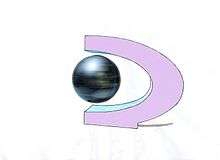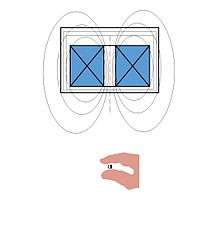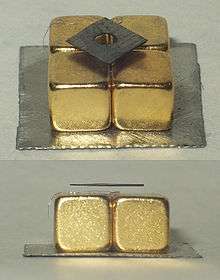Magnetic levitation
Magnetic levitation (maglev) or magnetic suspension is a method by which an object is suspended with no support other than magnetic fields. Magnetic force is used to counteract the effects of the gravitational acceleration and any other accelerations.

The two primary issues involved in magnetic levitation are lifting forces: providing an upward force sufficient to counteract gravity, and stability: ensuring that the system does not spontaneously slide or flip into a configuration where the lift is neutralized.
Magnetic levitation is used for maglev trains, contactless melting, magnetic bearings and for product display purposes.
Lift
Magnetic materials and systems are able to attract or press each other apart or together with a force dependent on the magnetic field and the area of the magnets. For example, the simplest example of lift would be a simple dipole magnet positioned in the magnetic fields of another dipole magnet, oriented with like poles facing each other, so that the force between magnets repels the two magnets.[1]
Essentially all types of magnets have been used to generate lift for magnetic levitation; permanent magnets, electromagnets, ferromagnetism, diamagnetism, superconducting magnets and magnetism due to induced currents in conductors.
To calculate the amount of lift, a magnetic pressure can be defined.
For example, the magnetic pressure of a magnetic field on a superconductor can be calculated by:
where is the force per unit area in pascals, is the magnetic field just above the superconductor in teslas, and = 4π×10−7 N·A−2 is the permeability of the vacuum.[2]
Stability
Earnshaw's theorem proves that using only paramagnetic materials (such as ferromagnetic iron) it is impossible for a static system to stably levitate against gravity.[3]
For example, the simplest example of lift with two simple dipole magnets repelling is highly unstable, since the top magnet can slide sideways, or flip over, and it turns out that no configuration of magnets can produce stability.
However, servomechanisms, the use of diamagnetic materials, superconduction, or systems involving eddy currents allow stability to be achieved.
In some cases the lifting force is provided by magnetic levitation, but stability is provided by a mechanical support bearing little load. This is termed pseudo-levitation.
Static stability
Static stability means that any small displacement away from a stable equilibrium causes a net force to push it back to the equilibrium point.
Earnshaw's theorem proved conclusively that it is not possible to levitate stably using only static, macroscopic, paramagnetic fields. The forces acting on any paramagnetic object in any combinations of gravitational, electrostatic, and magnetostatic fields will make the object's position, at best, unstable along at least one axis, and it can be in unstable equilibrium along all axes. However, several possibilities exist to make levitation viable, for example, the use of electronic stabilization or diamagnetic materials (since relative magnetic permeability is less than one[4]); it can be shown that diamagnetic materials are stable along at least one axis, and can be stable along all axes. Conductors can have a relative permeability to alternating magnetic fields of below one, so some configurations using simple AC driven electromagnets are self stable.
Dynamic stability
Dynamic stability occurs when the levitation system is able to damp out any vibration-like motion that may occur.
Magnetic fields are conservative forces and therefore in principle have no built-in damping, and in practice many of the levitation schemes are under-damped and in some cases negatively damped.[5] This can permit vibration modes to exist that can cause the item to leave the stable region.
Damping of motion is done in a number of ways:
- external mechanical damping (in the support), such as dashpots, air drag etc.
- eddy current damping (conductive metal influenced by field)
- tuned mass dampers in the levitated object
- electromagnets controlled by electronics
Methods
For successful levitation and control of all 6 axes (degrees of freedom; 3 translational and 3 rotational) a combination of permanent magnets and electromagnets or diamagnets or superconductors as well as attractive and repulsive fields can be used. From Earnshaw's theorem at least one stable axis must be present for the system to levitate successfully, but the other axes can be stabilized using ferromagnetism.
The primary ones used in maglev trains are servo-stabilized electromagnetic suspension (EMS), electrodynamic suspension (EDS).

Mechanical constraint (pseudo-levitation)
With a small amount of mechanical constraint for stability, achieving pseudo-levitation is a relatively straightforward process.
If two magnets are mechanically constrained along a single axis, for example, and arranged to repel each other strongly, this will act to levitate one of the magnets above the other.
Another geometry is where the magnets are attracted, but constrained from touching by a tensile member, such as a string or cable.
Another example is the Zippe-type centrifuge where a cylinder is suspended under an attractive magnet, and stabilized by a needle bearing from below.
Another configuration consists of an array of permanent magnets installed in a ferromagnetic U-shaped profile and coupled with a ferromagnetic rail. The magnetic flux crosses the rail in a direction transversal to the first axis and creates a closed-loop on the U-shaped profile. This configuration generates a stable equilibrium along the first axis that maintains the rail centered on the flux crossing point (minimum magnetic reluctance) and allows to bear a load magnetically. On the other axis, the system is constrained and centered by mechanical means, such as wheels.[6]
Servomechanisms


The attraction from a fixed strength magnet decreases with increased distance, and increases at closer distances. This is unstable. For a stable system, the opposite is needed, variations from a stable position should push it back to the target position.
Stable magnetic levitation can be achieved by measuring the position and speed of the object being levitated, and using a feedback loop which continuously adjusts one or more electromagnets to correct the object's motion, thus forming a servomechanism.
Many systems use magnetic attraction pulling upwards against gravity for these kinds of systems as this gives some inherent lateral stability, but some use a combination of magnetic attraction and magnetic repulsion to push upwards.
Either system represents examples of ElectroMagnetic Suspension (EMS). For a very simple example, some tabletop levitation demonstrations use this principle, and the object cuts a beam of light or Hall effect sensor method is used to measure the position of the object. The electromagnet is above the object being levitated; the electromagnet is turned off whenever the object gets too close, and turned back on when it falls further away. Such a simple system is not very robust; far more effective control systems exist, but this illustrates the basic idea.
EMS magnetic levitation trains are based on this kind of levitation: The train wraps around the track, and is pulled upwards from below. The servo controls keep it safely at a constant distance from the track.
Induced currents
These schemes work due to repulsion due to Lenz's law. When a conductor is presented with a time-varying magnetic field electrical currents in the conductor are set up which create a magnetic field that causes a repulsive effect.
These kinds of systems typically show an inherent stability, although extra damping is sometimes required.
Relative motion between conductors and magnets
If one moves a base made of a very good electrical conductor such as copper, aluminium or silver close to a magnet, an (eddy) current will be induced in the conductor that will oppose the changes in the field and create an opposite field that will repel the magnet (Lenz's law). At a sufficiently high rate of movement, a suspended magnet will levitate on the metal, or vice versa with suspended metal. Litz wire made of wire thinner than the skin depth for the frequencies seen by the metal works much more efficiently than solid conductors. Figure 8 coils can be used to keep something aligned.[7]
An especially technologically interesting case of this comes when one uses a Halbach array instead of a single pole permanent magnet, as this almost doubles the field strength, which in turn almost doubles the strength of the eddy currents. The net effect is to more than triple the lift force. Using two opposed Halbach arrays increases the field even further.[8]
Halbach arrays are also well-suited to magnetic levitation and stabilisation of gyroscopes and electric motor and generator spindles.
Oscillating electromagnetic fields

A conductor can be levitated above an electromagnet (or vice versa) with an alternating current flowing through it. This causes any regular conductor to behave like a diamagnet, due to the eddy currents generated in the conductor.[9][10] Since the eddy currents create their own fields which oppose the magnetic field, the conductive object is repelled from the electromagnet, and most of the field lines of the magnetic field will no longer penetrate the conductive object.
This effect requires non-ferromagnetic but highly conductive materials like aluminium or copper, as the ferromagnetic ones are also strongly attracted to the electromagnet (although at high frequencies the field can still be expelled) and tend to have a higher resistivity giving lower eddy currents. Again, litz wire gives the best results.
The effect can be used for stunts such as levitating a telephone book by concealing an aluminium plate within it.
At high frequencies (a few tens of kilohertz or so) and kilowatt powers small quantities of metals can be levitated and melted using levitation melting without the risk of the metal being contaminated by the crucible.[11]
One source of oscillating magnetic field that is used is the linear induction motor. This can be used to levitate as well as provide propulsion.
Diamagnetically stabilized levitation

Earnshaw's theorem does not apply to diamagnets. These behave in the opposite manner to normal magnets owing to their relative permeability of μr < 1 (i.e. negative magnetic susceptibility). Diamagnetic levitation can be inherently stable.
A permanent magnet can be stably suspended by various configurations of strong permanent magnets and strong diamagnets. When using superconducting magnets, the levitation of a permanent magnet can even be stabilized by the small diamagnetism of water in human fingers.[12]
Diamagnetic levitation

Diamagnetism is the property of an object which causes it to create a magnetic field in opposition to an externally applied magnetic field, thus causing the material to be repelled by magnetic fields. Diamagnetic materials cause lines of magnetic flux to curve away from the material. Specifically, an external magnetic field alters the orbital velocity of electrons around their nuclei, thus changing the magnetic dipole moment.
According to Lenz's law, this opposes the external field. Diamagnets are materials with a magnetic permeability less than μ0 (a relative permeability less than 1). Consequently, diamagnetism is a form of magnetism that is only exhibited by a substance in the presence of an externally applied magnetic field. It is generally quite a weak effect in most materials, although superconductors exhibit a strong effect.
Direct diamagnetic levitation
A substance that is diamagnetic repels a magnetic field. All materials have diamagnetic properties, but the effect is very weak, and is usually overcome by the object's paramagnetic or ferromagnetic properties, which act in the opposite manner. Any material in which the diamagnetic component is stronger will be repelled by a magnet.
Diamagnetic levitation can be used to levitate very light pieces of pyrolytic graphite or bismuth above a moderately strong permanent magnet. As water is predominantly diamagnetic, this technique has been used to levitate water droplets and even live animals, such as a grasshopper, frog and a mouse.[13] However, the magnetic fields required for this are very high, typically in the range of 16 teslas, and therefore create significant problems if ferromagnetic materials are nearby.
The minimum criterion for diamagnetic levitation is , where:
- is the magnetic susceptibility
- is the density of the material
- is the local gravitational acceleration (−9.8 m/s2 on Earth)
- is the permeability of free space
- is the magnetic field
- is the rate of change of the magnetic field along the vertical axis.
Assuming ideal conditions along the z-direction of solenoid magnet:
Superconductors
Superconductors may be considered perfect diamagnets, and completely expel magnetic fields due to the Meissner effect when the superconductivity initially forms; thus superconducting levitation can be considered a particular instance of diamagnetic levitation. In a type-II superconductor, the levitation of the magnet is further stabilized due to flux pinning within the superconductor; this tends to stop the superconductor from moving with respect to the magnetic field, even if the levitated system is inverted.
These principles are exploited by EDS (Electrodynamic Suspension), superconducting bearings, flywheels, etc.
A very strong magnetic field is required to levitate a train. The JR–Maglev trains have superconducting magnetic coils, but the JR–Maglev levitation is not due to the Meissner effect.
Rotational stabilization
A magnet or properly assembled array of magnets with a toroidal field can be stably levitated against gravity when gyroscopically stabilized by spinning it in a second toroidal field created by a base ring of magnet(s). However, this only works while the rate of precession is between both upper and lower critical thresholds—the region of stability is quite narrow both spatially and in the required rate of precession.
The first discovery of this phenomenon was by Roy M. Harrigan, a Vermont inventor who patented a levitation device in 1983 based upon it.[14] Several devices using rotational stabilization (such as the popular Levitron branded levitating top toy) have been developed citing this patent. Non-commercial devices have been created for university research laboratories, generally using magnets too powerful for safe public interaction.
Strong focusing
Earnshaw's theory strictly only applies to static fields. Alternating magnetic fields, even purely alternating attractive fields,[15] can induce stability and confine a trajectory through a magnetic field to give a levitation effect.
This is used in particle accelerators to confine and lift charged particles, and has been proposed for maglev trains as well.[15]
Uses
Known uses of magnetic levitation include maglev trains, contactless melting, magnetic bearings and for product display purposes. Moreover, recently magnetic levitation has been approached in the field of microrobotics.
Maglev transportation
Maglev, or magnetic levitation, is a system of transportation that suspends, guides and propels vehicles, predominantly trains, using magnetic levitation from a very large number of magnets for lift and propulsion. This method has the potential to be faster, quieter and smoother than wheeled mass transit systems. The technology has the potential to exceed 6,400 km/h (4,000 mi/h) if deployed in an evacuated tunnel.[16] If not deployed in an evacuated tube the power needed for levitation is usually not a particularly large percentage and most of the power needed is used to overcome air drag, as with any other high speed train. Some maglev Hyperloop prototype vehicles are being developed as part of the Hyperloop pod competition in 2015–2016, and are expected to make initial test runs in an evacuated tube later in 2016.[17]
The highest recorded speed of a maglev train is 603 kilometers per hour (374.69 mph), achieved in Japan on April 21, 2015, 28.2 km/h faster than the conventional TGV speed record. Maglev trains exist and are planned across the world. Notable projects in Asia include Central Japan Railway Company's superconducting maglev train and Shanghai's maglev train, the oldest commercial maglev still in operation. Elsewhere, various projects have been considered across Europe and Northeast Maglev aims to overhaul North America's Northeast Corridor with JR Central's SCMaglev technology.
Magnetic bearings
- Magnetic bearings
- Flywheels
- Centrifuges
- Magnetic ring spinning
Levitation melting
Electromagnetic levitation (EML), patented by Muck in 1923,[18] is one of the oldest levitation techniques used for containerless experiments.[19] The technique enables the levitation of an object using electromagnets. A typical EML coil has reversed winding of upper and lower sections energized by a radio frequency power supply.
Microrobotics
In the field of microrobotics, strategies which exploit magnetic levitation have been investigated. In particular, it has been demonstrated that through such a technique, control of multiple microscale-sized agents within a defined workspace can be achieved.[20] Several research studies report the realization of different custom setups to properly obtain the desired control of microrobots. In Philips laboratories in Hamburg a custom clinical scale system, integrating both permanent magnets and electromagnets, was used to perform magnetic levitation and 3D navigation of a single magnetic object.[21] Another research group integrated a higher number of electromagnets, thus more magnetic degrees of freedom, to achieve 3D independent control of multiple objects through magnetic levitation.[22]
Historical beliefs
Legends of magnetic levitation were common in ancient and mediaeval times, and their spread from the Roman world to the Middle East and later to India has been documented by the classical scholar Dunstan Lowe.[23][24] The earliest known source is Pliny the Elder (first century AD), who described architectural plans for an iron statue that was to be suspended by lodestone from the vault of a temple in Alexandria. Many subsequent reports described levitating statues, relics or other objects of symbolic importance, and versions of the legend have appeared in diverse religious traditions, including Christianity, Islam, Buddhism and Hinduism. In some cases they were interpreted as divine miracles, while in others they were described as natural phenomena falsely purported to be miraculous; one example of the latter comes from St Augustine, who refers to a magnetically suspended statue in his book The City of God (c. 410 AD). Another common feature of these legends, according to Lowe, is an explanation of the object's disappearance, often involving its destruction by non-believers in acts of impiety. Although the phenomenon itself is now understood to be physically impossible, as was first recognized by Samuel Earnshaw in 1842, stories of magnetic levitation have persisted to modern times, one prominent example being the legend of the suspended monument in the Konark Sun Temple in Eastern India.
History
- 1839 Earnshaw's theorem showed electrostatic levitation cannot be stable; later theorem was extended to magnetostatic levitation by others
- 1913 Emile Bachelet awarded a patent in March 1912 for his “levitating transmitting apparatus” (patent no. 1,020,942) for electromagnetic suspension system
- 1933 Superdiamagnetism Walther Meissner and Robert Ochsenfeld (the Meissner effect)
- 1934 Hermann Kemper “monorail vehicle with no wheels attached.” Reich Patent number 643316
- 1939 Braunbeck’s extension showed that magnetic levitation is possible with diamagnetic materials
- 1939 Bedford, Peer, and Tonks aluminum plate placed on two concentric cylindrical coils shows 6-axis stable levitation.[25]
- 1961 James R. Powell and BNL colleague Gordon Danby electrodynamic levitation using superconducting magnets and "Null flux" figure 8 coils[7]
- 1970s Spin stabilized magnetic levitation Roy M. Harrigan
- 1974 Magnetic river Eric Laithwaite and others
- 1979 transrapid train carried passengers
- 1981 First single-tether magnetic levitation system exhibited publicly (Tom Shannon, Compass of Love, collection Musee d'Art Moderne de la Ville de Paris)
- 1984 Low speed maglev shuttle in Birmingham Eric Laithwaite and others
- 1997 Diamagnetically levitated live frog Andre Geim[13]
- 1999 Inductrack permanent magnet electrodynamic levitation (General Atomics)
- 2000 The first man-loading HTS maglev test vehicle “Century” in the world was successfully developed in China.[26]
- 2005 homopolar electrodynamic bearing[27]
See also
- Acoustic levitation
- Aerodynamic levitation
- Electrostatic levitation
- Optical levitation
- Cyclotrons levitate and circulate charged particles in a magnetic field
- Inductrack a particular system based on Halbach arrays and inductive track loops
- Launch loop
- Levitron
- Linear motor
- Magnetic bearing
- Magnetic ring spinning
- Nagahori Tsurumi-ryokuchi Line
- Rapid transits using linear motor propulsion
- StarTram is an extreme proposal for levitation via superconductors over multiple kilometers of distance
- Zippe-type centrifuge uses magnetic lift and a mechanical needle for stability
References
- calculator Archived 2014-08-19 at the Wayback Machine for force between two disc magnets (retrieved April 16, 2014)
- Lecture 19 MIT 8.02 Electricity and Magnetism, Spring 2002
- Ignorance = Maglev = Bliss For 150 years scientists believed that stable magnetic levitation was impossible. Then Roy Harrigan came along. By Theodore Gray Posted February 2, 2004
- Braunbeck, W. (1939). "Freischwebende Körper im elektrischen und magnetischen Feld". Zeitschrift für Physik. 112 (11): 753–763. Bibcode:1939ZPhy..112..753B. doi:10.1007/BF01339979.
- Rote, D.M.; Yigang Cai (2002). "Review of dynamic stability of repulsive-force maglev suspension systems". IEEE Transactions on Magnetics. 38 (2): 1383. Bibcode:2002ITM....38.1383R. doi:10.1109/20.996030.
- https://wired.jp/2018/02/23/ironlev-from-italy/
- "Maglev2000 bio of James R. Powell". Archived from the original on 2012-09-08. Retrieved Feb 15, 2017.CS1 maint: BOT: original-url status unknown (link)
- S&TR | November 2003: Maglev on the Development Track for Urban Transportation Archived 2012-10-10 at the Wayback Machine. Llnl.gov (2003-11-07). Retrieved on 2013-07-12.
- Thompson, Marc T. Eddy current magnetic levitation, models and experiments. (PDF) . Retrieved on 2013-07-12.
- Levitated Ball-Levitating a 1 cm aluminum sphere. Sprott.physics.wisc.edu. Retrieved on 2013-07-12.
- Mestel, A. J. (2006). "Magnetic levitation of liquid metals". Journal of Fluid Mechanics. 117: 27–43. Bibcode:1982JFM...117...27M. doi:10.1017/S0022112082001505.
- Diamagnetically stabilized magnet levitation. (PDF) . Retrieved on 2013-07-12.
- "The Frog That Learned to Fly". Radboud University Nijmegen. Retrieved 19 October 2010. For Geim's account of diamagnetic levitation, see Geim, Andrey. "Everyone's Magnetism" (PDF). (688 KB). Physics Today. September 1998. pp. 36–39. Retrieved 19 October 2010. For the experiment with Berry, see Berry, M. V.; Geim, Andre. (1997). "Of flying frogs and levitrons" (PDF). Archived from the original (PDF) on 2010-11-03. (228 KB). European Journal of Physics 18: 307–313. Retrieved 19 October 2010.
- US patent 4382245, Harrigan, Roy M., "Levitation device", issued 1983-05-03
- Hull, J.R. (1989). "Attractive levitation for high-speed ground transport with largeguideway clearance and alternating-gradient stabilization". IEEE Transactions on Magnetics. 25 (5): 3272–3274. Bibcode:1989ITM....25.3272H. doi:10.1109/20.42275.
- Trans-Atlantic MagLev | Popular Science. Popsci.com. Retrieved on 2013-07-12.
- Lavars, Nick (2016-01-31). "MIT engineers win Hyperloop pod competition, will test prototype in mid-2016". www.gizmag.com. Retrieved 2016-02-01.
- Muck, O. German patent no. 42204 (Oct. 30, 1923)
- Nordine, Paul C.; Weber, J. K. Richard & Abadie, Johan G. (2000). "Properties of high-temperature melts using levitation". Pure and Applied Chemistry. 72 (11): 2127–2136. doi:10.1351/pac200072112127.
- Xu, Tiantian; Yu, Jiangfan; Yan, Xiaohui; Choi, Hongsoo; Zhang, Li (2015). "Magnetic Actuation Based Motion Control for Microrobots: An Overview". Micromachines. 6 (9): 1346–1364. doi:10.3390/mi6091346. ISSN 2072-666X.
- Dao, Ming; Rahmer, Jürgen; Stehning, Christian; Gleich, Bernhard (2018). "Remote magnetic actuation using a clinical scale system". PLOS ONE. 13 (3): e0193546. Bibcode:2018PLoSO..1393546R. doi:10.1371/journal.pone.0193546. ISSN 1932-6203. PMC 5832300. PMID 29494647.
- Ongaro, Federico; Pane, Stefano; Scheggi, Stefano; Misra, Sarthak (2019). "Design of an Electromagnetic Setup for Independent Three-Dimensional Control of Pairs of Identical and Nonidentical Microrobots". IEEE Transactions on Robotics. 35 (1): 174–183. doi:10.1109/TRO.2018.2875393. ISSN 1552-3098.
- website of Dr Dunstan Lowe https://www.kent.ac.uk/european-culture-languages/people/1744/lowe-dunstan. Retrieved 30 May 2019. Missing or empty
|title=(help) - Lowe, Dunstan (2016). "Suspending Disbelief: Magnetic Levitation in Antiquity and the Middle Ages" (PDF). Classical Antiquity. 35: 247–278. doi:10.1525/ca.2016.35.2.247. Retrieved 30 May 2019.
- Laithwaite, E.R. (1975). "Linear electric machines—A personal view". Proceedings of the IEEE. 63 (2): 250–290. Bibcode:1975IEEEP..63..250L. doi:10.1109/PROC.1975.9734.
- Wang, Jiasu; Wang Suyu; et al. (2002). "The first man-loading high temperature superconducting maglev test vehicle in the world". Physica C. 378–381: 809–814. Bibcode:2002PhyC..378..809W. doi:10.1016/S0921-4534(02)01548-4.
- "Design and Analysis of a Novel Low Loss Homopolar Electrodynamic Bearing." Lembke, Torbjörn. PhD Thesis. Stockholm: Universitetsservice US AB, 2005. Print. ISBN 91-7178-032-7
External links
- Maglev Trains Audio slideshow from the National High Magnetic Field Laboratory discusses magnetic levitation, the Meissner Effect, magnetic flux trapping and superconductivity
- Magnetic Levitation – Science is Fun
- Magnetic (superconducting) levitation experiment (YouTube)
- Superconducting Levitation Demos
- Maglev video gallery
- How can you magnetically levitate objects?
- Levitated aluminum ball (oscillating field)
- Instructions to build an optically triggered feedback maglev demonstration
- Videos of diamagnetically levitated objects, including frogs and grasshoppers
- Larry Spring's Mendocino Brushless Magnetic Levitation Solar Motor
- A Classroom Demonstration of Levitation...
- 25kg MAGLEV suspension setup
- 25kg MAGLEV suspension control via Classical control strategy
- 25kg MAGLEV suspension via State feedback control strategy
- Frogs levitate in a strong enough magnetic field
- Example of Mechanical Constraint Levitation
